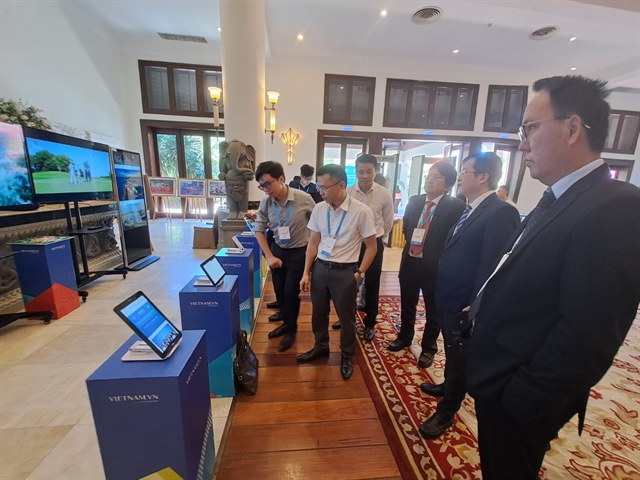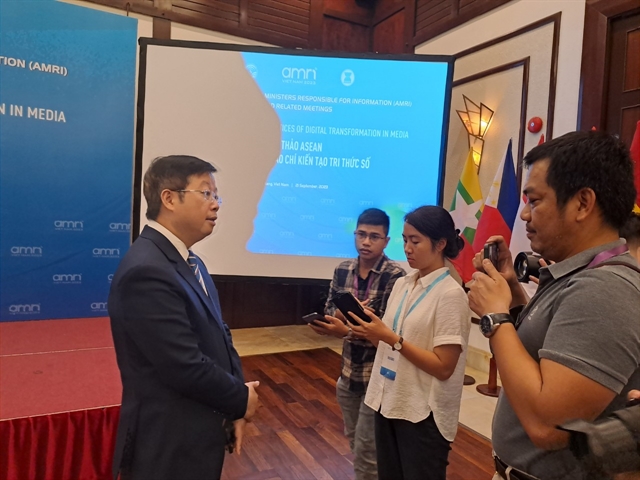 Society
Society

Traditional media has been combating social networks in regaining readers and profitable commercial market share by promoting the use of technology and facial design as well as providing what the readers are looking for.

|
| Deputies visit a showroom of digital transformation demonstration at the ASEAN Workshop on best practices of digital transformation in media in Đà Nẵng. VNS Photo Công Thành |
ĐÀ NẴNG — Most local media and printed newspapers in Việt Nam have been drastically transforming to digital for survival in the mass domination by social networks over the past decade, and it requires a comprehensive face-lift in technology, practice and a marketable master plan.
That was the message from Phạm Anh Tuấn, an official from the Ministry of Information and Communications of Việt Nam at the ASEAN Workshop on best practices of digital transformation in media.
He said traditional media has been combating social networks in regaining readers and profitable commercial market share by promoting the use of technology and facial design as well as providing what the readers are looking for.
Tuấn said technological applications play a key role in the media digital transformation process, but all structure of production, skills and knowledge of reporters, technicians and the content of stories must completely change.
“Traditional media was tumbled by social networks as readers found them attractive and easy. Social network platforms could detect the habits of users to offer what they need. It’s the reason social networks almost occupy a major section of income and readers from media,” Tuấn said.

|
| Local media join an interview at the ASEAN Workshop on best practices of digital transformation in media. Media has been changing into digital transformation for survival. VNS Photo Công Thành |
“That’s why media now has to have social network design and performance to lure readers. The fake news contamination in social networks recently sped up a chance for media to refresh it to better connect and gain trust among consumers.”
Tuấn explained that the mainstream media has a crucial role in leading the public by posting truthful and confident sources of news.
Different key media organisations have successfully regained power through technological platform changes and design, he said.
For example, the government online newspaper (Việt Nam Government News) previously received 100,000 hits, but it got 1 million views after a digital platform change, he said.
“It needs a common platform for news coverage and commercial marketing to retain stable readers and income from online advertisement,” Tuấn suggested.
Zul Fakhri Maidy, assistant Chief editor for News and Current Affairs, Radio Television Brunei, shared that the digital economy master plan 2025, launched in 2020, aims to make it a ‘smart nation’ and achieve the goals of a digital and future-ready society; a vibrant and sustainable economy and a digitally conducive ecosystem.
He said the Ministry of Transport and Information Communications’ Strategic Plan 2025's target was to achieve 75 per cent of household internet subscriptions by 2025.
Facebook was seen as a top social media application used by respondents with 60.6 per cent using it, and 57.6 per cent using Instagram with YouTube occupying 57.2 per cent.
Lưu Đình Phúc, Director General of the Authority of Press under the Ministry of Information and Communications of Việt Nam said the country had more than 800 news agencies and nearly 1 million news articles produced daily.
However, 50 per cent of ads from media revenue reaching nearly US$4 billion were run on cross-border platforms, while government and state agencies could not effectively control the ownership of data, news and stories from domestic media.
He said the government needs to support and promote the digital transformation from news agencies into a large database to generate knowledge.
He also recommended that ASEAN should develop a common index of press digital transformation maturity, and each ASEAN member state should develop its own tool for measuring the maturity of press digital transformation.

|
| Participants share discussions at the 16th Conference of ASEAN Ministers Responsive for Information and Related Meetings (AMRI) in Đà Nẵng City. VNS Photo Công Thành |
Deputy Minister of Information and Communication, Nguyễn Thanh Lâm, said the consumption habits of media users and the content creation and dissemination process have undergone a rapid and unprecedented transformation.
“A new generation of digital-era consumers has set the pace for adaptation, and everything is on the line: market shares, advertising, business models, intellectual property, storytelling methods, but, most importantly, our ability to inform, educate, empower citizens, and preserve and pass on our legacy to future generations,” Lâm said.
“Media outlets must do their important mission by providing accurate facts and meaningful analysis, protection of the public from contaminated fake news and disinformation.”
Myanmar developed a digital economy roadmap in 2019, an e-Government Master Plan (2016-20), and a Framework for Economic and Social Reform (2012-15).
Myanmar’s digital transformation focused on administration, education, health and social sectors, and amendments were made to the draft of Myanmar e-Governance Master Plan 2030.
Print media, electronic media and online media businesses in Myanmar serve as sources of information, education and entertainment for the people, said Myat Kyaye Hmore from Myanmar's Ministry of Information.
According to the public relations department of Thailand, the country’s government has been supporting digital transformation with a 20-year-Thailand digital landscape from 2017 with four phases.
It also ensures everyone can reap the benefits of digital technology after five years before promoting full digital transformation and driving the country with digital technology and innovation.
Thailand targets becoming a global digital leader in digital technology and innovation in the coming decades.
In Việt Nam, a mainstream national television station (VTV); online VNExpress and K-Plus were seen as top leading media in digital transformation.
Launched in 2015 with the goal of ‘watching VTV anytime, anywhere, on any device', the VTVGo platform was born from years of investment in the digital infrastructure of content production, Phạm Mạnh Chiến from VTV said.
VTVGo has been installed on over 42 million devices, with more than 8 million regular users, generating 240 million views per month.
Nguyễn Đăng Lộc from VnExpress, a Vietnamese online newspaper, run by FPT Group, said it was the first newspaper in Việt Nam that was not produced in paper format.
It is one of the most popular websites in the country according to Alexa Internet.
In 2020, its website had 10 billion views and received more than 5 million comments, with an average session duration of five minutes and 44 seconds.
Lộc said it launched an analytics system to detect the habits of users for making decisions on offering readers further related news or not.
He said the newspaper will be using AI to support readers’ and advertisement demands.
K+ is a pay TV service based on satellite TV and OTT systems, for all members of the family with exclusive content, diversified channel group, nationwide coverage, HD quality and many convenient services such as the free myK+ application to watch on computers and phones with unique VOD movies and sports stores.
Ministers of information and communications from ASEAN will gather in the opening ceremony of the 16th Conference of ASEAN Ministers Responsive for Information and Related Meetings (AMRI) on September 22. VNS




